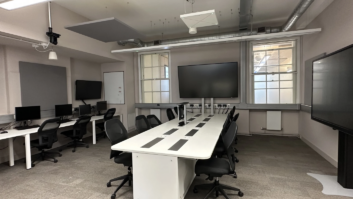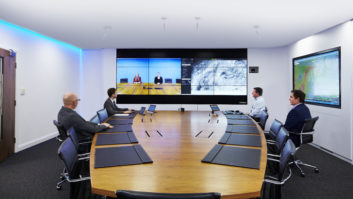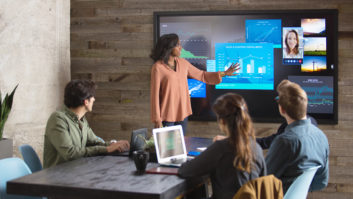
We have all read a lot of articles recently about how the audio-visual industry should embrace the new way of working and the challenges the pandemic has introduced, to pivot our approach and solutions to meet these new challenges. Use the pandemic as an opportunity. More end users will work from a greater variety of locations in the future, although no one can yet predict by how much, or where, or what that hybrid mix will look like, and it will vary between vertical markets.
I expect that most end users are fed up with webinars and media editorials that are titled ‘the new way of working’, or ’the new workspace’, or similar. Although I make no apology for using the phrase in the opening paragraph. And it is not that these are not important topics, but pivoting solutions, especially within a large corporate enterprise comes with many challenges, and should they do anything? Do they need to do anything… yet?
Coping mechanisms
Most corporate enterprise customers have coped and transitioned to a different way of working at the start of this pandemic, some more successfully than others, and they are probably wondering whether they need to change anything again when their staff return to the office, or can they just return to their pre pandemic approach? Especially as they do not know when that return will be, or what it will actually look like.
There are a lot of predictions being made, especially by suppliers’ keen for end users to adopt their new solutions, but can those predictions be guaranteed?
Change is dependent on the agility of the end user and for large corporate enterprise customers all change takes time. More time than most people realise. Even a single software release update across a global enterprise must follow a formal change control process which often starts by testing the new release in a lab. With staff not going into the office, even more straightforward changes like these have been made more difficult during the pandemic. Not everything can be checked and tested remotely, and labs cannot easily be reproduced in employees’ homes.
Question time
We know that conference and collaboration processes have had to change because of the pandemic, but will that be the case going forward? Users have been forced to adapt and attend more virtual meetings than ever before, and not necessarily from the place they were previously used to joining from.
Will they want to when the return to work happens? Might they have had enough of video meetings and webinars and crave in person interaction? Has anyone considered that perhaps their initial desire will be in person meetings at all cost, at least for an interim period? Unlike before the pandemic, corporate meeting spaces are currently no longer the primary participant in a conference/collaboration session, but will this continue when staff eventually return to the office? Will users return to their pre pandemic behaviours, or will they continue to embrace the change that was forced on them?
When deploying new solutions, the question should always be about the people and process, not the technology – although the technology can be the catalyst for change.
If the technology they now have hasn’t changed sufficiently to better accommodate their new ways of connecting then there is little doubt users will return to previous behaviours. If, however the technology solutions and processes being used are working and can be modified to make it easier – ie, as an enabler – then surely the users will adapt and embrace the change.
Applied approach
However, any approach to change needs to be applied across every element of the experience or process, not just focused on the technology platform providing the ‘connection’.
The booking or scheduling platform and process, for example, need to accommodate the expected ‘new way of working’ and probably should no longer be focused on the booking of space/s
but rather focusing on the resources required to make the experience successful, measured from the end user’s perspective. That should include the people and the tools they require but probably leave the location where they join from open to the user’s choice.
An employee does not want to be forced to attend the office on a day they prefer to be remote, whether at home or travelling, or have a reduced experience, or miss out completely because they cannot connect from wherever they are.
And this does not just apply to meetings or meeting space technology solutions. Many of the same challenges apply across all AV technology solutions in the Corporate Enterprise including digital signage, production, post-production, and distribution –eg, streaming and, of course, live events.
Now put yourself in the shoes of the corporate enterprise customer. Every solution is integrated, especially in today’s ‘connected’ world, and not just in an audio-visual sense, or system. They are integrated with many other technology solutions, like personnel databases, service ticketing systems, catering systems, messaging and presence, and must work across multiple devices, networks, and locations.
And ultimately, they want a user experience that’s simple, intuitive and combined, not a solution that requires switching between multiple interfaces.
And then, moreover, there is the impact on the network bandwidth and network security, other topics we all get bored with hearing about, but must deal with.
Different verticals
Every corporate enterprise customer also works in a different vertical market, each of which are experiencing their own unique challenges, and the way forward coming out of Covid will be different for each.
So, imagine the challenges associated with changing one piece of the jigsaw that is the corporate enterprise conference and collaboration solution set today. Each piece touches many other elements, and all these touch points must be managed when making change. Fundamentally this all takes time, and much of this requires interaction between multiple technology teams, suppliers, and partners to be successful.
These are the real challenges that corporate enterprise clients face every day, not just during a pandemic. So then add the challenges associated with the pandemic and it is clear why many corporates have paused once they had taken the initial steps to accommodate
the pandemic impact.
Add to that the unpredictability of the future, when things might ‘open up’ and what that might look like, and not forgetting the additional consideration of the value of their investment, they still want an ROI, you then start to understand the complexity of the beast.
The motivation therefore to make change for the corporate enterprise customer needs to be significant and will always be measured against an internal user requirement or benefit, not external industry pressures.
These are all also opportunities, and those suppliers that recognise that and pivot their approach to these needs and challenges will undoubtedly be the more successful moving forward.







